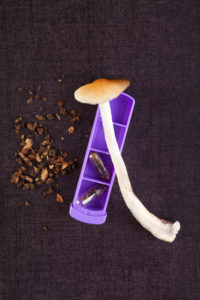Microdosing has been used to study the behavior of drugs in humans by administering subtherapeutic doses of the drug (extremely low doses that are not likely to produce large effects). Typically, in the research process, this is referred to as a Phase 0 study. It is done to determine whether the drug is viable for the next phase of testing for potential use in humans. Microdosing may help to identify any potentially dangerous side effects.
Microdosing also refers to the use of extremely small doses of a drug to achieve certain types of psychoactive effects. For instance, the drug LSD was initially designed to be used for pregnant women, and the doses used were very small. The dose of LSD used by individuals who use the drug for its psychoactive effects is minimal compared to the amounts of drugs other people use.
Increasing Popularity of Microdosing
The concept of microdosing has regained new popularity as a result of the book The Psychedelic Explorer’s Guide written by Dr. James Fadiman, a psychologist. This book was designed to be a how-to manual for achieving psychedelic drug experiences. However, it also has led to the practice of taking drugs (most often, psychedelic drugs like LSD or psilocybin [magic mushrooms]) in doses so small that they are below the threshold of perception. Essentially, the amounts are so minor that they do not result in the person having the psychedelic/hallucinogenic experiences of the drug.
There are reports from numerous people from around the world who have experimented with psychedelic microdosing to treat anxiety, depression, and attention deficit hyperactivity disorder (ADHD). Some of these reports also suggest there may be enhanced cognitive effects and the potential for this practice to increase productivity.
How Does Microdosing Work?
According to Fadiman’s book, the practice requires that someone take an extremely small amount of the drug like psilocybin or LSD (one-fifth to one-tenth of the normal dose used by individuals attempting to experience hallucinations) at specific intervals; the book recommends every three days.
According to users, it seems to rebalance them. Those who engage in this practice usually will not formally measure out a specific microdose but will use their judgment in deciding what amount of the drug they should take.
Is There Research to Support This?

In an interview with HuffPost in 2015, Fadiman reported that he was collecting data from the self-reports of individuals who engage in microdosing. His findings were positive, which is not surprising as the reports are all anecdotal reports..
A few scattered research reports rely on the self-reports of individuals who engage in this practice. A recent report investigating the approach of microdosing was clear to state that the findings, although generally positive, were based on the self-reports of individuals and not obtained under formal research conditions. The self-reports of people undergoing this practice suggest that it might relieve minor depression.
There have been no formal clinical trials using standard research methodology to test the effects of this particular form of therapy. Very often, anecdotal evidence like self-reports for interventions that treat conditions that cannot be readily measured objectively (like pain or depression) suffers from placebo effects. A placebo effect occurs when a substance that is known to have no particular benefit produces that benefit in individuals who use it.
Formal clinical methodologies, such as randomized controlled trials where researchers and participants do not know who is getting the drug and who is getting an inert substance (a placebo), are better equipped to determine if a specific substance has a therapeutic effect.
At the time of this writing, there are no such trials in the literature regarding the microdosing of these drugs and any therapeutic benefits. Therefore, any findings from the aforementioned book or online essentially have no basis for substantiation and should be treated with skepticism.
Are There Potential Dangers?

Based on the above-listed sources, LSD is the drug most popularly microdosed. LSD is a primary hallucinogenic drug that results in the experience of hallucinations (most often, visual and auditory hallucinations), altered perceptions of objects in the environment, and time distortions. It is commonly used by people to expand their consciousness.
Microdosing of LSD is not designed to produce these effects but is allegedly designed to heighten awareness, boost creativity, and result in the sense of well-being that reportedly may counteract the effects of depression. The long-term effects of LSD use are generally considered to be relatively benign in most individuals, and those who take minimal amounts of the drug at periodic intervals are most likely not at significant risk for health issues.
Other popular hallucinogens that are used in microdoses include psilocybin (the active substance in magic mushrooms), and mescaline (the chemical in peyote).
There appears to be little risk for individuals to become physically dependent on any of these substances. If they are taken at the intervals suggested in tiny amounts, they most likely will not result in serious side effects in most people. As mentioned above, the reported positive effects of microdosing these drugs have not been clinically tested.
Also, these drugs are controlled substances in the Schedule I classification. This means that individuals caught with any amount of these drugs are subject to prosecution. Therefore, it appears that the cost of possessing drugs, even in very small amounts, clearly outweighs the benefits.
There is some evidence that some individuals are attempting to use the drug MDMA (ecstasy) for periodic microdosing. Some studies suggest that MDMA may be useful in the treatment of some psychiatric issues, such as post-traumatic stress disorder or depression. However, this is an extremely dangerous drug, and this practice should be discouraged unless one is under the supervision of a physician.
At the time of this writing, there is no clinical evidence to suggest that microdosing MDMA has any therapeutic benefits.
Finally, as mentioned above, the practice of microdosing appears to be haphazard and inconsistent among individuals who claim to do so. The majority of individuals in one survey who admitted to microdosing at least once guessed at how much the microdose would be for them.
This could lead to an unsafe situation if individuals are not careful about the amount of the drug they are using. Because the effects associated with microdosing are very mild if they exist at all, some individuals may continue to take the drug and eventually overdose on it.
Can Microdosing Lead to Depression?
There appears to be no evidence that microdosing any of the above drugs can cause a person to experience depressive symptoms. Certainly, individuals who use large amounts of the drugs, experience the psychoactive effects of the drugs, and then experience a crash or comedown as it is metabolized may experience depressive symptoms; however, this does not appear to be probable with individuals who microdose the drug.
Conclusions
Based on the available evidence, the following can be concluded:
- There is no scientific evidence that the practice of microdosing with hallucinogenic drugs like LSD is a valid approach to clinical depression despite some anecdotal evidence that it may reduce everyday stress.
- Even though microdosing requires a person to only intermittently use tiny amounts of a particular drug, microdosing with certain drugs like MDMA is still potentially dangerous.
- There will be no formal approval of the practice of microdosing to treat clinical depression until there are clinical trials performed, and the results of these trials can be shown to be reliable.
- Individuals who struggle with clinical depression or think they may have a diagnosis of depression should consult with a mental health care professional

